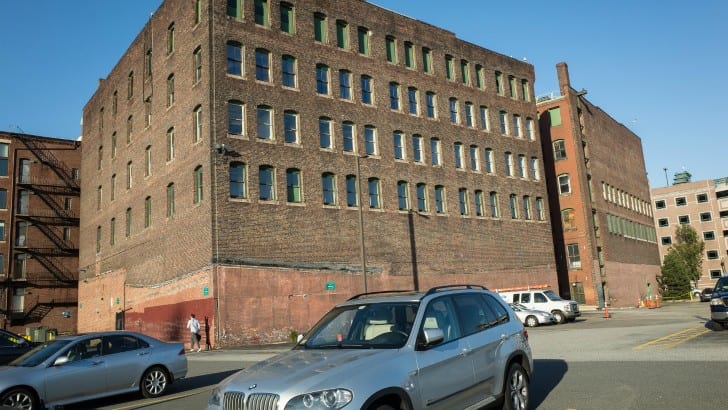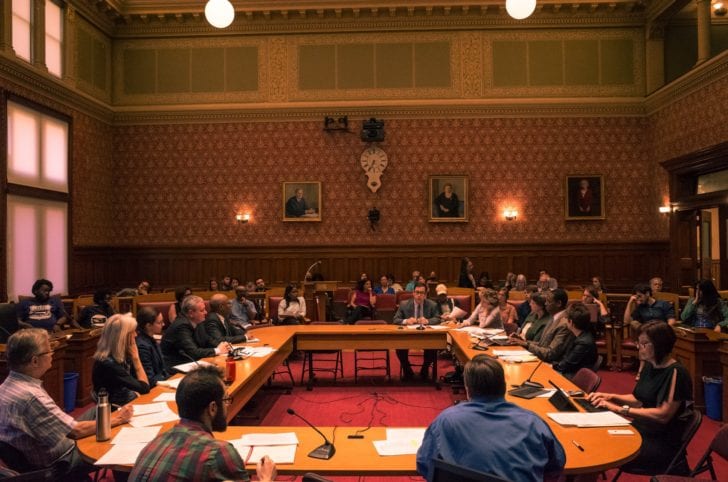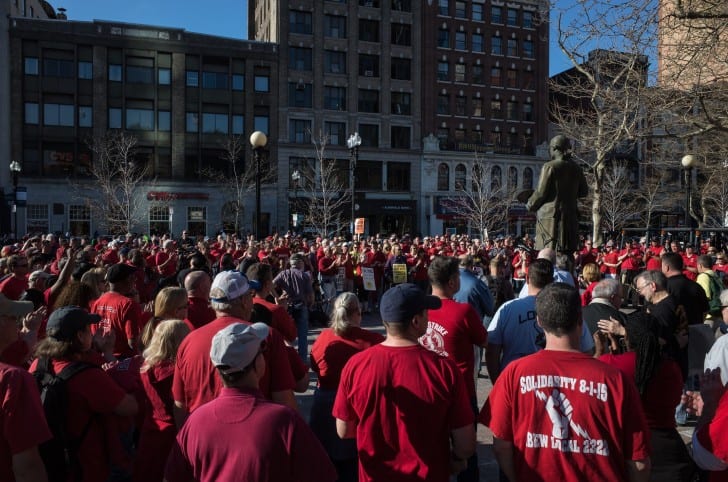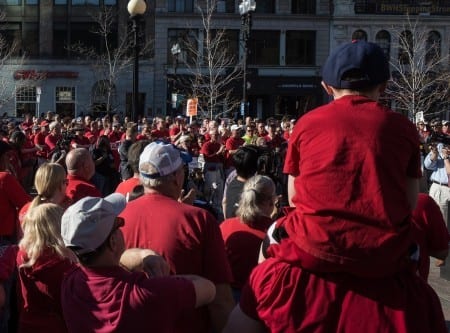
Photo by Jason Pramas. Copyright 2016 Jason Pramas.
June 21, 2016
BY JASON PRAMAS @JASONPRAMAS
Problems with GE Fort Point arrangement show need for democratic economic development planning
A new wrinkle surfaced earlier this month in the plan to use a big chunk of the $270 million in public aid and tax breaks being shoveled at General Electric to buy two of the three buildings that are slated to make up its new headquarters in Boston’s Fort Point neighborhood.
In part 5 of this ongoing series of columns on the GE Boston deal, I mentioned that said scheme called for the Boston Redevelopment Authority (BRA) to purchase the two former Necco company buildings from Procter & Gamble—along with part of the big parking lot outside its Gillette plant—and lease the buildings back to General Electric. Soon after, it emerged that while GE would pay up to an estimated $100 million to refurbish the buildings and build a new third structure on the site, it would not be paying rent. At all. For the entire 20 years of the lease. And that the terms of the agreement struck with the City of Boston and the Commonwealth of Massachusetts only put the vast multinational on the hook for “annual operating expenses, property taxes not abated or subject to a PILOT [Payment In Lieu of Taxes] agreement, and interior renovations costs.”
John Barros, Boston’s chief of economic development, subsequently insisted that despite the agreement making no mention of rent payments for the former Necco buildings, by gum there would be some kind of payments! Yet there has been no further news on what those payments might look like. Or if the company will, in fact, ever be asked to make any payments in exchange for using the buildings at all.
Key to the plan was BRA ownership of the buildings—because that allowed GE, a corporate behemoth infamous for making huge profits and paying very little in taxes, to use the part of the promised $120 million in state grants that wasn’t used by the BRA to purchase the buildings to rehab them and make other site improvements. Since the state money in question cannot be used on private property.
Now it turns out that the BRA won’t be involved in the deal at all. Instead, according to the Boston Business Journal (BBJ), the state’s economic development arm MassDevelopment will own the Necco buildings and the $120 million in state funds “would be used in [its] acquisition of the Necco buildings as well as to improve utilities at the site, create a public park and improve the existing Harborwalk.”
As regards the lack of rent, a rather uncritical April 1 BBJ piece, “Of course GE won’t pay rent in Boston, so stop bellyaching,” noted that “the revitalized site could generate roughly $1.75 million in annual gross tax revenues to the city.” An estimated $35 million over 20 years. The next day, the Boston Globe quoted a higher estimate using “City Hall” figures indicating that a “comparably sized office property in that part of the city” would pay $48 million in taxes over 20 years—which a later Boston.com piece interpreted as the city pocketing $23 million over its $25 million in tax abatements to GE.
But when WGBH’s Jim Braude had interviewed Boston Mayor Marty Walsh a few days prior, hizzoner agreed there had been no discussion of GE paying taxes to the city to that point. After first putting it as an evasive double negative, “There’s been no discussion of not paying taxes.”
All that said, it comes down to this: The City of Boston and the Commonwealth of Massachusetts are giving millions of public dollars to a mind-blowingly wealthy conglomerate that doesn’t need it. To engineer the public purchase of two out of three headquarters buildings on which it will likely not pay much, if any, rent. Nor will GE likely pay significant taxes on the parts of the complex it is to own outright—if its past record as one of the biggest tax scofflaws in history is any guide.
The terms of the essentially secret deal that led to this situation—brokered by high public officials and GE leadership with no public oversight whatsoever—are already being violated. The place of the BRA in the complicated and highly questionable real estate transaction at the heart of the accord has now been taken by MassDevelopment. Once again with no opportunity for public comment or oversight.
Things just happen. Politicians and CEOs cut backroom deals. Much of the press lays down on the job. And the public gets shafted.
But what if the public didn’t have to bow down to private interests? What if we didn’t have to get shafted on deals like this? Imagine a Boston and a Massachusetts in which the public good—rather than short term gain for a few privileged actors—was the guiding political economic motivation.
Let’s say that the same city and state money being lavished on General Electric was put into something that many people have said was important—like strengthening and expanding the arts sector in Fort Point in ways that go much further than anything proposed in the city’s new arts plan. A sector that, after all, was largely responsible for making what the BRA likes to call the “Seaport District” attractive to big developers and corporate interests to begin with.
In that alternate Boston, the city and state would pull out of the GE deal. The state would buy the Necco buildings directly from P&G. Perhaps it would pick up the adjacent 253 Summer Street building as well. And it could even buy some of the available P&G parking lot and build desperately needed public housing—following the mixed-use zoning ideas for the area in the 2006 BRA “100 Acres Plan” a good deal more closely than that agency is at the moment. City and state money would refurbish the space as a creative industries incubator with an emphasis on new businesses run as worker-owned co-operatives. The focus of the project would be twofold. Create good arts jobs, and help Fort Point remain a major arts hub. That would be a much better use of public money than dumping it on GE. Especially because the entire development process would be transparent and subject to democratic oversight.
A robust popular movement will be required to make this kind of vision a reality. And such movements rarely appear on cue. But it sure would be nice if one did this time around.









